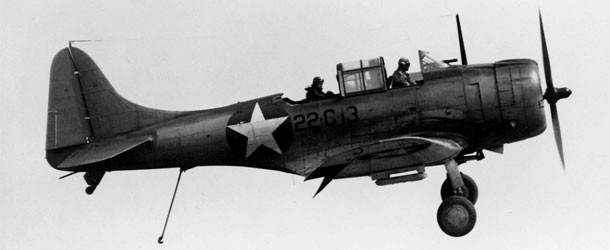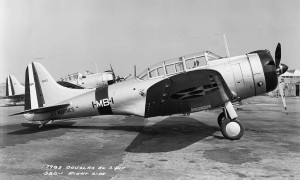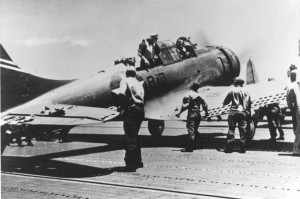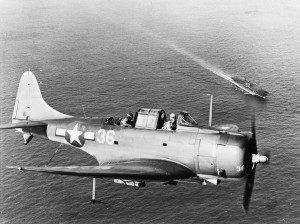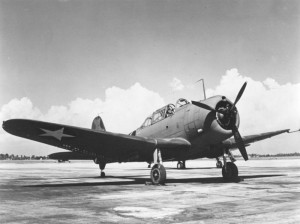Getting back to the WW2 airplanes recently featured in Wings of Glory, let’s learn more about the Douglas SBD Dauntless - the US Navy’s main carrier-borne scout plane and dive–bomber from mid-1940 through mid-1944. These airplanes delivered the fatal blows to the Japanese carriers at the Battle of Midway in June 1942.
The SBD ("Scout Bomber Douglas") was noteworthy for its long range, good handling characteristics, maneuverability, potent bomb load, great diving characteristics, good defensive armament and its ruggedness. It was designed and produced based on the Northrop BT-1 design, of Northrop Corporation, which was bought out by the Douglas Company in 1917.
The BT-1 was a low-wing cantilever configuration, with a two-man tandem cockpit with dual flight controls and hydraulically actuated perforated split dive-brakes. It was powered by an 825 hp (615 kW; 836 PS) R-1535-94 engine. After several major modifications, such as the change of the landing gear, from retracting backwards into large fairing trousers beneath the wings (to folding laterally into recessed wheel wells), leading edge slots, and a redesigned canopy, the Douglas Company got a new model, the XBT-2, which first flew in April 1938 and became the forerunner of the Dauntless.
The BT-2 was powered by a 1,000 hp Wright XR-1820-32 radial engine. It got the new designation, Douglas SBD-1 in 1939. The first order from the Navy was for 144 aircrafts, and the last 87 were completed as SBD-2, with increased fuel capacity and different armament. The SBD-1 went to the Marine Corps in late 1940, and the SBD-2 to the Navy in early 1941.
By then, a new version started to be manufactured, the SBD-3, with increased armor, self-sealing fuel tanks, and four machine guns. The SBD-3 was the first fully combat ready version with a total production of 585 airplanes. It was followed by the SBD-4, which provided a 12-volt (up from the prior 6-volt) electrical system.
The SBD-5 was the main production model – a total of 2,965 were built, equipped with a larger 1,200 hp Wright R-1820-60 engine. The engine air intake was removed from the upper cowling which was the main distinguishing mark of all earlier models. The bomb load was increased to 2,250 lb (1,020 kg), and the twin 0.30 in (7.62 mm) rearward-firing guns were factory installed. Its armament also included two 0.50 in (12.7 mm) forward-firing synchronized Browning M2 machine guns in engine cowling.
The last version of the aircraft was the SBD-6, fitted with a 1,350 hp Wright R-1820-66 engine and equipped with ASV (Air to Surface Vessel) radar. The all-metal fuel tanks were replaced by self-sealing bladder fuel tanks with a total capacity of 284 gallons. There was also a land-based variant of the SBDs, the A-24 Banshee, without an arrestor hook, produced for the U.S. Army Air Force.
The first Dauntlesses were delivered to the Navy squadron USMC VMB-2, in late 1940, and VMB-1, in early 1941. By December 1941, when the Japanese Navy attacked Pearl Harbor, the Dauntless was the standard dive bomber. It was the first US Navy plane to sink an enemy ship (Japanese sub I-70) in WWII, just three days after the attack. The first massive action was on May 7,1942, at the Battle of the Coral Sea, when the US aircraft carriers USS Lexington and USS Yorktown faced three Japanese carriers. Dauntless fought well alongside other US aircraft and were credited with forty of the ninety-one enemy aircraft downed.
Half the aircraft on U.S. carriers in the first year of the war were SBD Dauntless. They sank or helped sink six carriers, one battleship, three cruisers, one submarine, and 14 transports in this period. This was nearly 30 percent of the total tonnage of the Imperial Japanese Navy’s prewar fleet.
On scouting missions, 18 SBDs flew in pairs, searching a 90-degree pie slice of the ocean, locating enemy ships and patrolling for submarines. On bombing missions, they conducted high-payoff, high-risk attacks on Japanese shipping and land targets, plunging almost vertically and releasing bombs at low levels.
At the Battle of Midway, four squadrons of Navy SBD dive bombers attacked and sank or fatally damaged all four Japanese fleet carriers present, and they also caught two straggling heavy cruisers of the Midway bombardment group of four, heavily damaging them, with the Mikuma eventually sinking.
In the Guadalcanal Campaign, from August 1942 to February 1943, SBDs attacked Japanese shipping throughout the campaign, and proved lethal to Japanese shipping that failed to clear the slot by daylight. They sank the carrier Ryūjō, near the Solomon Islands on 24 August. Three other Japanese carriers were damaged during the six-month campaign.
The Dauntless saw action also in the Atlantic Ocean, during Operation Torch, when the Allied landings in North Africa in November 1942. The SBDs operated from the USS Ranger and two escort carriers. In Europe, they took part of the air attack conducted by the United States Navy against German shipping near Bodø, Norway, on 4 October 1943.
The Douglas SDB Dauntless was called “Slow but Deadly”, as it revealed itself to be also surprisingly good at fighting other aircrafts. It is one of the few bombers in history to have more air combat victories than losses. The Dauntless equipped twenty Marine squadrons during the WW2 and were retained until late 1944. It was also used by French Air Force and Naval Aviation and the Royal New Zealand Air Force.
Douglas SDB Dauntless in Wings of Glory
In Wings of Glory, the SDB Dauntless is featured in three versions: two Douglas SBD-5, piloted by Major Christian C. Lee and Lt. JG Kirkendahl, and an A-24 Banshee used by a Free France squadron, under the command of Sergent Chef Albin Roger Louis Ruet. The aircraft uses the Maneuver Deck “I”. It was extremely sturdy and even if not so maneuverable, it could execute two different vertical dive maneuvers, like the dives but shorter. The three models come with the additional card “Dive bombing”, which allows them to decide to drop bombs after executing two sharp dives, one after the other, and before the firing phase.

A formation of SBD-5 Dauntless from Marine Scouting Squadron 3 (VMS-3) in flight near the Virgin Islands.
Christian C. Lee (VMS-3)
Christian C. Lee was born April 13, 1918, in Hyde Park, Utah. He enlisted in the Marine Corps in 1940. After graduating from flight school, in 1942, he was assigned to anti-submarine warfare patrol duty in the Atlantic. Promoted to major, he became commanding officer of a Corsair squadron and participated in the Marshall Island campaigns. He flown the Douglas Dauntless at the Marine Scouting Squadron VMS–3, the only Marine Corps squadron to operate east of the United States, performing search, patrol, and convoy escort duties in the Caribbean until 1944.
Major Lee later fought in the battle of Okinawa, in Spring 1945, as commanding officer of a fighter squadron, shooting down a Japanese plane and leading bombing strikes against airfields in Japan. After WW2, he served as commanding officer of a Marine Tactical Control squadron at the Korean War, joining the 1st Marine Brigade in the Pusan Perimeter Battle of July 1950. He was awarded the Silver Star medal for bravery while leading marines out of the Chosin Reservoir.
Later assignments included commanding officer of the famous VMF-214 Black Sheep fighter squadron; commanding officer of a Marine Air Reserve training detachment in New York; and commanding officer of a Marine dive bomber squadron in Miami, Fla. In 1958, he became the 1st Marine Air Wing Safety Officer in Japan. Lee retired in 1961 as a lieutenant colonel after 21 years in the Marine Corps, having flown 23 different types of aircraft from single engine biplanes to supersonic jets and multiple engine transports. He also had a commercial pilots license flying for Pan American Airways. He passed away on 24 January, 2002, in California.
The Douglas Dauntless SBD-5 flown by him depicted in Wings of Glory includes the skill card “Fire Expert”.
Albin Roger Louis Ruet (FAFL)
Born in December 1919, Albin Roger Lous Ruet was a pilot of the GC 1/18 Véndee, a unit of the Free French Air Force (Forces Aériennes Françaises Libres). He got his tourism flight license when he was 19 years old. He enlisted in the army and was assigned to the military aviation, obtaining his brevet in 1940. He served in the bases of Pau, Toulouse, Algiers Maison-Blanche and Fez before being demobilized.
He rejoined the FAFL very late on July 29, 1943 (registered with the air company of Damascus under the number 41.442) declaring one hundred and thirty hours of flight, essentially on training plane. Assigned to "Picardie", he was appointed sergeant-chef and joined the Patrie Group, which became GCB I/18 "Vendée". This squadron flew Banshee A-24Bs in support of Allied forces in southern France. The unit flew from North Africa to recently liberated Toulouse to support Allied and French resistance troops. Later, the unit was assigned to support attacks on cities occupied by the Germans on the French Atlantic coast.
On October 21, 1944, during the German attack in Nostang (Morbihan), Ruet, with his crew of the first squadron of Patrie, allowed the FAFL to maintain their position and was later honored with the Croix du Guerre avec Palme. On November 6, 1944, he was flying a Douglas A24 in a strafing mission in the Lorient pocket when it was hit by antiaircraft fire and crashed in Sainte-Hélène (Morbihan). Ruet and the observer, Captain Boucherie, were killed; they had performed 19 missions together.
Ruet’s Banshee has the Olive drab camouflage of Vendée squadron, and comes with the skill card “Perfect Control”.
Lt. JG Kirkendahl (VB-16)
The third Douglas SBD featured in WW2 Wings of Glory was an aircraft piloted by Lt. JG Kirkendahl, who flew in the bombing squadron VB-16 during the Pacific War. There is no information available about the pilot, except that he was the commander of the SBD-5 S/N 28469 lost in Mille, Central Pacific, on November 19, 1943. About his squadron, it was equipped with 34 Dauntless, operated from USS Lexington during the period September 1943-June 1944. The VB-16 took part in the attack against the Japanese Fleet during the Battle of the Philippine Sea, the largest carrier-to-carrier battle in history, in June 1944.

A Douglas SBD-5 Dauntless of VB-16 preparing to launch from USS Lexington, on a strike in the Central Pacific.
During this battle, a long range twilight strike was made against the retreating Japanese fleet, at the limit of the attacking airplanes' combat radius. The force had about twenty minutes of daylight over their targets before attempting the long return in the dark. Of the 215 aircrafts, only 115 made it back, and among these were all 26 SBDs which took off for the strike. The Dauntless was one of the most important aircraft in the Pacific War, sinking more enemy shipping in the War in the Pacific than any other Allied bomber. /p>
The Kirkendahl/VB-16 model includes the skill card “Precision Dive Bomb Aimer”.
Information sources: Pacif Aviation Museum, Aviation History, Warbird Alley, Wikipedia, HJ News, Liste des Français Libres.

